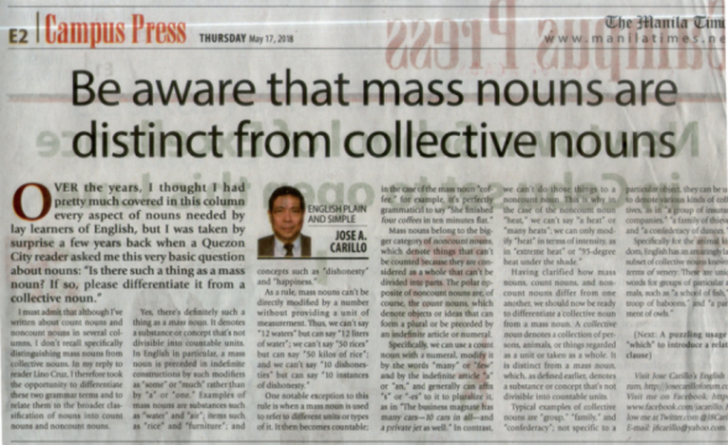Over the years, I thought I had pretty much covered in this column every aspect of nouns needed by lay learners of English, but I was taken by surprise a few years back when a Quezon City reader asked me this very basic question about nouns: “Is there such a thing as a mass noun? If so, please differentiate it from a collective noun.”
IMAGE CREDIT: WWW.SLIDESHARE.NETI must admit that although I’ve written about count nouns and noncount nouns in several columns, I don’t recall specifically distinguishing mass nouns from collective nouns. In my reply to reader Lino Cruz, I therefore took the opportunity to differentiate these two grammar terms and to relate them to the broader classification of nouns into count nouns and noncount nouns.
IMAGE CREDIT: HIVEMINER.COMYes, there’s definitely such a thing as a
mass noun. It denotes a substance or concept that’s not divisible into countable units. In English in particular, a mass noun is preceded in indefinite constructions by such modifiers as “some” or “much” rather than by “a” or “one.” Examples of mass nouns are substances such as “water” and “air”; items such as “rice” and “furniture”; and concepts such as “dishonesty” and “happiness.”
As a rule, mass nouns can’t be directly modified by a number without providing a unit of measurement. Thus, we can’t say “12 waters” but can say “12 liters of water”; we can’t say “50 rices” but can say “50 kilos of rice”; and we can’t say “10 dishonesties” but can say “10 instances of dishonesty.”
One notable exception to this rule is when a mass noun is used to refer to different units or types of it. It then becomes countable; in the case of the mass noun “coffee,” for example, it’s perfectly grammatical to say “She finished
four coffees in ten minutes flat.”
Mass nouns belong to the bigger category of
noncount nouns, which denote things that can’t be counted because they are considered as a whole that can’t be divided into parts. The polar opposite of noncount nouns are, of course, the
count nouns, which denote objects or ideas that can form a plural or be preceded by an indefinite article or numeral.
Specifically, we can use a count noun with a numeral, modify it by the words “many” or “few” and by the indefinite article “a” or “an,” and generally can affix “s” or “-es” to it to pluralize it, as in “The business magnate has
many cars—
10 cars in all—and
a private jet as well.” In contrast, we can’t do those things to a noncount noun. This is why in the case of the noncount noun “heat,” we can’t say “a heat” or “many heats”; we can only modify “heat” in terms of intensity, as in “extreme heat” or “95-degree heat under the shade.”
Having clarified how mass nouns, count nouns, and noncount nouns differ from one another, we should now be ready to differentiate a collective noun from a mass noun. A
collective noun denotes a collection of persons, animals, or things regarded as a unit or taken as a whole. It is distinct from a
mass noun, which, as defined earlier, denotes a substance or concept that’s not divisible into countable units.
IMAGE CREDIT: HILLOFBOOKS.ORGTypical examples of collective nouns are “group,” “family,” and “confederacy”; not specific to a particular object, they can be used to denote various kinds of collectives, as in “a group of insurance companies,” “a family of thieves,” and “a confederacy of dunces.”
Specifically for the animal kingdom, English has an amazingly large subset of collective nouns known as
terms of venery. These are unique words for groups of particular animals, such as “a school of fish,” “a troop of baboons,” and “a parliament of owls.”
 This essay appeared in the column “English Plain and Simple” by Jose A. Carillo in the Campus Press section of the May 17, 2018 issue (print edition only) of
This essay appeared in the column “English Plain and Simple” by Jose A. Carillo in the Campus Press section of the May 17, 2018 issue (print edition only) of The Manila Times
, © 2018 by the Manila Times Publishing Corp. All rights reserved.(Next:
A puzzling usage of “which” to introduce a relative clause) May 24, 2018